Central Bankers Join the Ranks of Climate Activists
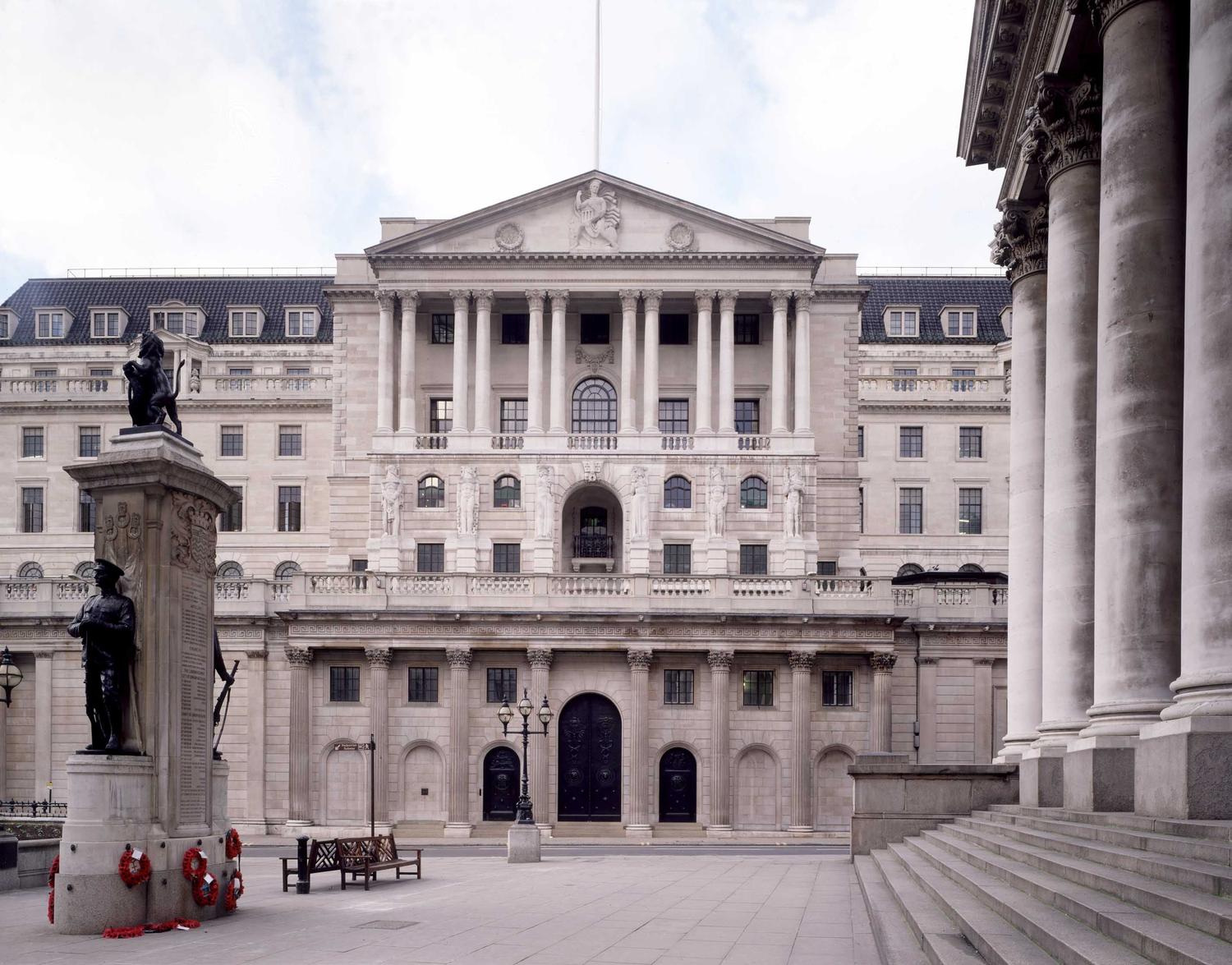

What do Extinction Rebellion, Greta Thunberg and the Bank of England have in common? They are all climate activists in their own unique way.
What do Extinction Rebellion, Greta Thunberg and Mark Carney, governor of the Bank of England, have in common?
All share a passionate concern for the looming human costs of climate inaction. Late last month, as Extinction Rebellion protestors occupied central London, and Sweden’s Greta Thunberg implored the European Parliament to heed climate scientists’ warnings, Carney and his fellow central bankers proved to be unlikely allies.
In a strongly-worded Guardian article, Carney and his French counterpart, François Villeroy de Galhau, called for a “massive reallocation of capital” to address the climate threat.
The bankers’ call to action coincided with the publication of the first report by the Network for Greening the Financial Systems (NGFS). Made up of 36 central banks on five continents, whose economies emit half the world’s greenhouse gas emissions, the network seeks to coordinate collective financial sector action in support of the Paris Agreement goals. Members include Australia, Canada, China, Colombia, France, Germany, Mexico, the Netherlands, Singapore, Switzerland and the United Kingdom. The U.S. Federal Reserve is the most prominent absent institution.
The NGFS report, A Call to Action: Climate Change as a Source of Financial Risk, offers a blueprint for central banks, supervisors, policymakers and financial institutions to “green the financial system” and reduce disruptive climate-related financial risks. It urges all central banks to integrate climate risks in monitoring the financial stability of banking systems, and to lead by example by incorporating sustainability criteria in their own portfolios. Other recommendations include working together to plug data gaps, and share knowledge, to improve how financial institutions assess climate risks in a rapidly warming world. The report also backed the growing movement for consistent and transparent corporate climate risk disclosure, exemplified by the Financial Stability Board’s Task Force on Climate-Related Financial Disclosures.
The NGFS has grown rapidly since its Paris launch with eight members in December 2017, by French President Emmanuel Macron. Central bankers’ interest in voluntary climate action reflects rising concern over the costs of climate impacts, including a fivefold increase in insured losses over the past three decades. In 2018 alone, insurers shouldered a record-breaking $160 billion in climate-related losses as intensifying heatwaves, storms, droughts and floods struck around the globe. Another concern is that banks lending to fossil fuel reliant companies may face steep financial losses if assets such as coal and oil deposits become stranded.
The report marks a new willingness by central banks to wade into the climate arena. In their Guardian article, Carney and Villeroy de Galhau explained why: “The prime responsibility for climate policy will continue to sit with governments. And the private sector will determine the success of the adjustment. But as financial policymakers and prudent supervisors, we cannot ignore the obvious risk before our eyes.”
It’s the same argument that Extinction Rebellion, Greta Thunberg and her fellow student activists around the world make, as they protest in the streets and the corridors of power.
Image credit: Bank of England/Flickr
Adobe Digital Academy Brings More Diverse Talent to Tech


Editor's Note: This story is part of an editorial series featuring companies on CR Magazine's 20th annual 100 Best Corporate Citizens ranking, which recognizes outstanding environmental, social, and governance (ESG) disclosure and performance among the Russell 1,000 Index. You can follow the series here.
Adobe’s 2018 Corporate Social Responsibility Report just dropped, revealing new information about its efforts to build talent in technology and creative fields. As the tech sector—and the U.S. economy overall—face increasing talent shortages, efforts such as these are all the more crucial for companies like Adobe. And early investments in this area are already paying off for the Silicon Valley software firm.
The Adobe Creativity Scholarships program has now supported an impressive 137 students from more than 25 countries, covering the costs of tuition for students pursuing a degree in the arts or inspiring positive change via creativity.
Even more promising is the Adobe Digital Academy, which launched in 2016 and is a unique take on the tech talent pipeline that’s showing positive results already. The program is separated into three parts:
- An intensive, immersive three-month bootcamp that teaches web development or user experience design skills, funded by a scholarship and stipend from Adobe.
- A paid technical apprenticeship/internship with Adobe, during which students are embedded in engineering and design teams.
- Support in securing full-time employment, either at Adobe or other tech companies.
Of the 47 internships completed thus far, 25 have resulted in full-time positions at Adobe, Michelle Crozier, the company’s director of brand purpose and social impact, told TriplePundit.
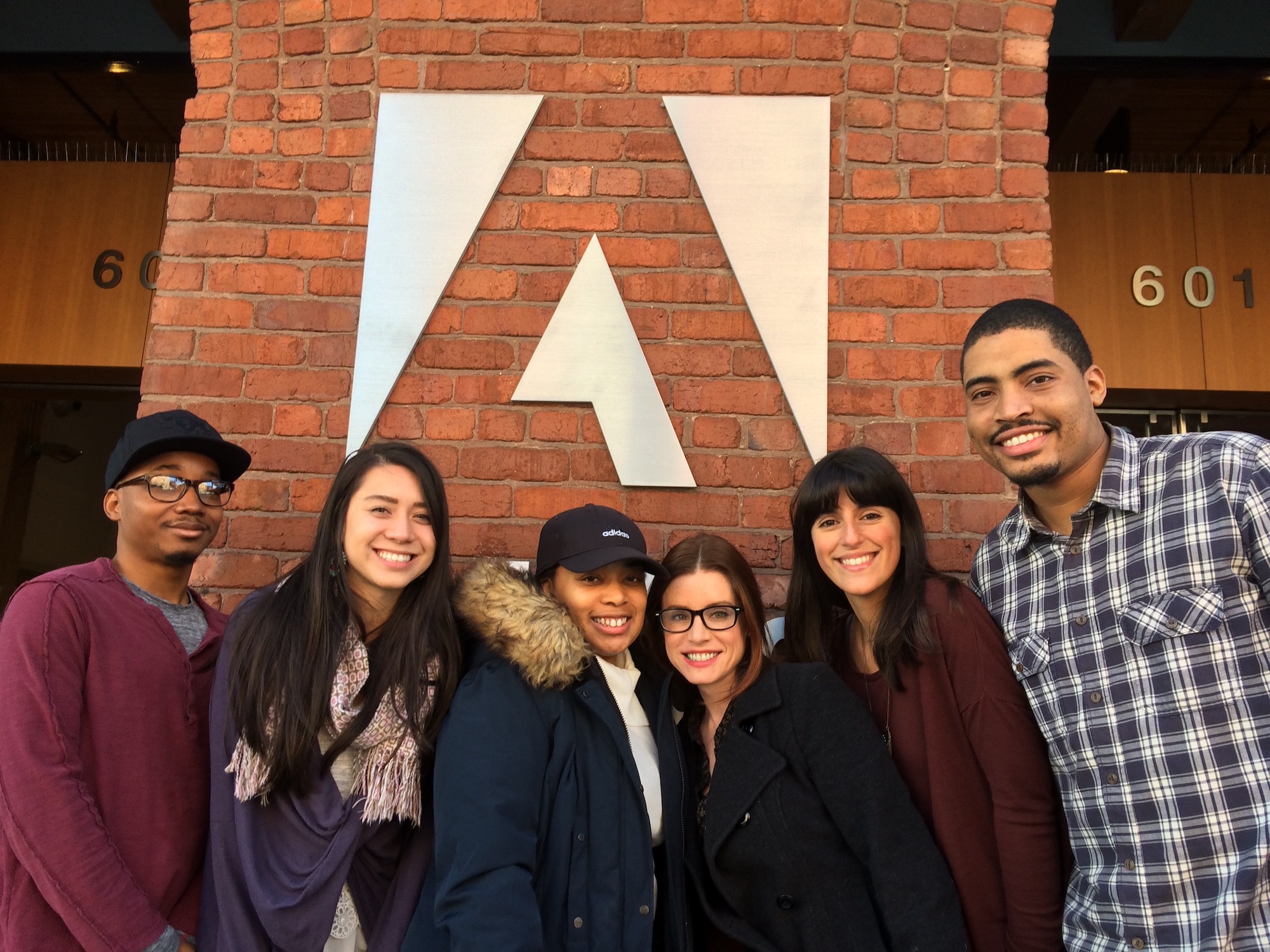
Coding bootcamps are a common phenomenon these days, and it’s not unusual for tech companies to sponsor one or even create their own to ensure a steady drip of new talent. Tech bootcamps regularly churn out competent developers to feed the insatiable demand of the growing tech industry.
What makes Adobe’s program so exceptional is that it flips the bootcamp paradigm on its head. Many comparable programs cost money, up to tens of thousands of dollars, for a similar education. The Academy actually pays the students a modest stipend to support them during their rigorous studies so they can focus fully on learning the material without having to hold a part-time job.
In fact, it would be more apt to compare the Adobe Digital Academy to an accelerator than a bootcamp. Not only do students receive funding, but there’s also a robust support network to help them succeed in the program and prepare them for a job in the technology field. They have access to individual mentors, job experience with immediate feedback, and a group of dedicated peers and alumni.
The secret ingredient, however, isn’t the money or the resources. It’s the people.
The Adobe Digital Academy specifically seeks out nontraditional applicants: people from outside the technology field, who are willing to quit their jobs and risk it all in an industry with which they have little to no experience. Many of them are from demographics underrepresented in tech and demonstrate economic need.
Crozier spoke on their potential. “There was a significant amount of skepticism that these candidates could qualify even for an internship, much less a job, with no previous tech training” she told us. “But we've been blown away by the caliber and the capability of these individuals.”
These candidates are already driven and passionate about the opportunity to learn, grow and form successful careers. Adobe partners with several nonprofit organizations, such as Digital Nest and Hack the Hood, to expand its reach and seek out individuals with the potential to thrive in the program.
The Adobe Digital Academy is yet another example illustrating that diversity is a strong contributor to company growth and especially profit. Instead of treating it as a box for HR to tick off, successful companies are actively investing in diversity—such as Adobe including people from different industries and professional backgrounds. These sorts of initiatives create an influx of new ideas, innovations and tactics which directly impact the bottom line.
As Adobe continues to succeed in building talent from nontraditional sources, other companies’ ears are perking up. “Every day, we get a call from a company that wants to know how we did it,” Crozier told us.
Programs like this one are a win-win for everyone involved. Let’s hope it continues to inspire positive change across the industry.
Images courtesy of Adobe and Arif Riyanto/Unsplash
CR Magazine Announces 100 Best Corporate Citizens of 2019

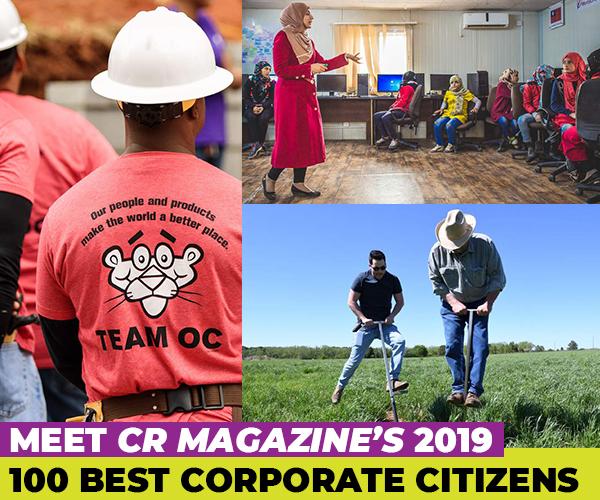
Along with the news and views we share here every weekday, the TriplePundit editorial team also produces CR Magazine, a biannual print publication focused on corporate responsibility. Like TriplePundit, the magazine features thought leaders from business and civil society who are driving positive change for people and the planet. Additionally, every year CR Magazine recognizes outstanding environmental, social and governance (ESG) transparency and performance among America's largest public companies through the 100 Best Corporate Citizens ranking.
The ranking represents the top 10 percent of the Russell 1,000 Index based on their disclosures in areas like climate change, employee relations and human rights, as determined by our research partner, ISS Corporate Solutions.
This year, Owens Corning tops the ranking, followed by Intel, General Mills, Campbell Soup and HP, Inc. Twenty-seven companies are new to the ranking in 2019 including Allstate, Delta Airlines and Mondelez International, while companies like Ball Corp., CBRE, Ford and Xylem, Inc. saw the biggest gains compared to 2018.
To compile the ranking, information is obtained only from publicly available resources, rather than questionnaires or company submissions, and there is no fee for companies to participate or verify their data. In other words, this isn't a pay-for-play—it's based on measurable, publicly-available information, assessed by a third party.
"U.S. corporate leadership matters more than ever to drive progress despite government gridlock around environmental and social topics like climate change,” said Dave Armon, CEO of 3BL Media, which publishes CR Magazine. “Each year, we measure the increasingly competitive progress of brands on ESG topics. Transparency and public commitments make corporate responsibility and sustainability programs stronger. We congratulate those honored on this year's ranking for their commitment to the triple bottom line."
While compiling the Summer 2019 edition of CR Magazine, we noticed that many of the 100 Best Corporate Citizens had something in common, beyond the ESG metrics they disclose to investors and the public.
Most of these companies do not measure their corporate responsibility and citizenship solely by gallons of water saved or tons of emissions avoided. Instead, they're taking the time to determine where they're best positioned to drive impact and leveraging their core competencies to tackle challenges far larger than themselves.
Over the next two weeks here on TriplePundit, we'll take a closer look at some of the 100 Best Corporate Citizens and how they're scaling impact around the world. Some are rallying their peers to tackle climate change and resource scarcity, while others are working to boost inclusion in their sectors or channeling their people and products to solve some of the toughest challenges we face. New stories will publish every day, and you can follow the series here.
At Ball Corp., Innovation Drives Impact (And Business Growth)
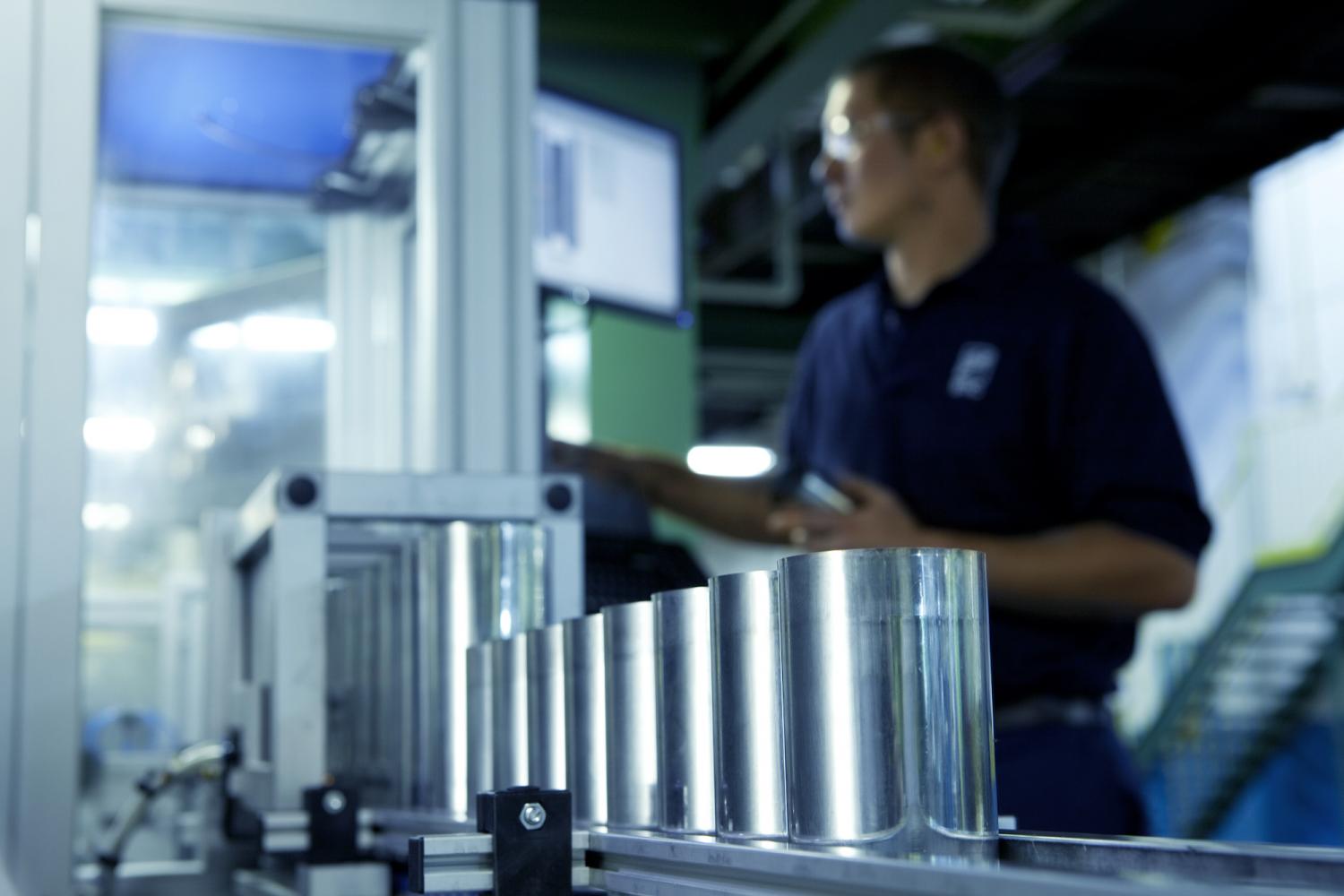
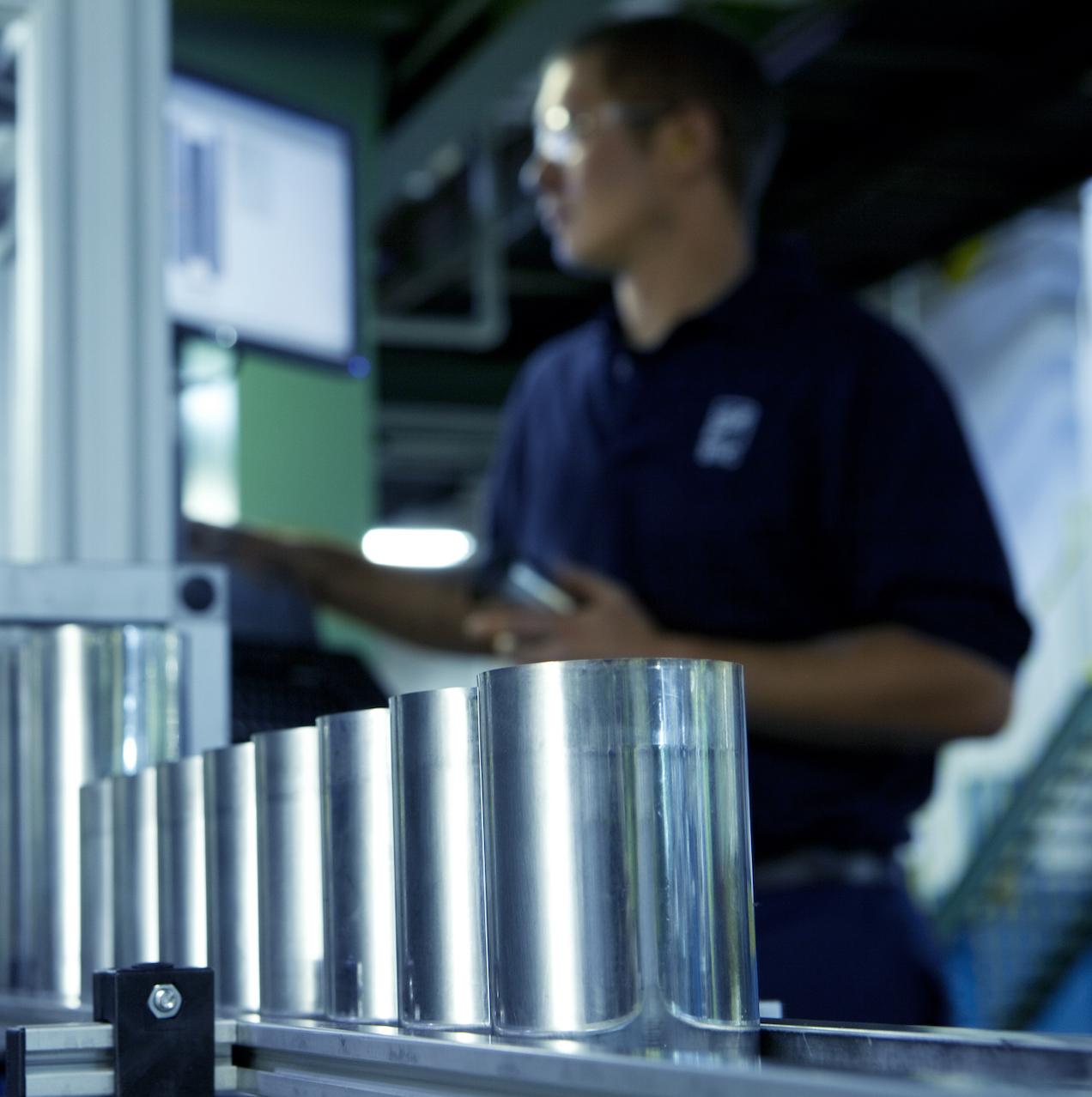
Editor's Note: This story is part of an editorial series featuring companies on CR Magazine's 20th annual 100 Best Corporate Citizens ranking, which recognizes outstanding environmental, social, and governance (ESG) disclosure and performance among the Russell 1,000 Index. You can follow the series here.
Over the course of its nearly 140-year history, Ball Corp. diversified out of glass canning jars and into metal packaging and aerospace services. Those twin fields are now very much in play as the company seeks to adapt to the circular economy and reduce its climate impacts.
Engineering progress toward a circular economy
Metal packaging—aluminum, steel and tin—gets high marks for recyclability. However, the urgency of climate action has added a new wrinkle. Whether made from virgin or recycled sources, packaging still has a carbon footprint throughout the manufacturing chain. Carbon emissions related to shipping also continue to trail packaging through the distribution chain to the consumer, and back again for recycling or disposal.
The key factor for packaging is weight, just as it is for the aerospace industry. And, as with the aerospace field, packaging companies need to continue innovating for decarbonization throughout the lifecycle. The reason is simple: Clients are demanding more sustainable packaging.
One illustrative example is Ball’s proprietary ReAl aluminum, used in its aerosol cans. Ball engineered ReAl to beat the industry standard for weight. The first version was 11 percent lighter than conventional cans. In 2015, Ball developed an improved version that achieved a 15 percent weight reduction, and the company is currently researching additional ways to cut weight from its cans.
A broader perspective on the circular economy
Still, weight is just one part of the circular economy challenge. A quick look at Ball’s 2018 sustainability report indicates the complexities of decarbonizing for a growing, diversified company. On the other hand, the report indicates that companies can have a broad impact on the circular economy, within their own field and potentially far beyond.
Ball CEO John A. Hayes explains: “Many of the innovative space systems that Ball Aerospace builds support actionable environmental intelligence, and allow scientists and other stakeholders to better understand and address key sustainability challenges, such as the circular economy, climate change, water stewardship and responsible sourcing.”
In one recent example, the U.S. Air Force selected Ball to develop a “next-generation” environmental satellite system called WXF-M. Ball anticipates that the new microwave-based system will become an invaluable source for tracking ocean plastic pollution in addition to other uses.
Closer to home, Ball supports The Recycling Partnership and similar organizations that drive waste diversion efforts, alongside in-house programs that engage thousands of employees in recycling.
Adapting to new energy resources
Alongside its circular economy efforts, Ball began dipping into major renewable energy projects in 2015. The company initially committed to purchase power from three wind turbines near its plant in Findlay, Ohio, for a total capacity of 4.5 megawatts. (Whirlpool purchased two other wind turbines in the same project.) Last fall, the company announced it would add three more turbines with a similar capacity.
But that pales alongside Ball’s latest venture. In April of this year, the company entered into two renewable energy power purchase contracts, one for 161 megawatts of wind and the other for 227 megawatts of solar. In one fell swoop, that pair of contracts will enable Ball to source renewables for all the electricity used in its corporate, packaging, and aerospace operations in North America by the end of 2021.
Ball took advantage of two recent developments to achieve the jump up in scale. One is the emergence of “virtual” power purchase agreements for renewable energy. Virtual PPAs are a variation on the now-familiar PPA. They enable corporate power purchasers to guarantee themselves a supply of clean electrons, without having to create a whole new division to build, manage or market them.
The second development relates to savings on staff—and not re-inventing the wheel. Now that the renewable energy market has matured, expert consultants are available to help clean power buyers navigate their way through the process. Ball tapped Schneider Electric Energy and Sustainability Services to arrange its new wind and solar purchase.
Major purchases like these have a ripple effect on the cost and availability of renewables. They create economies of scale, grow the workforce, and motivate more investment dollars. With investment in renewables—as well as other areas ripe for sustainability innovation, such as the circular economy—companies like Ball are finding new opportunities to stand out from the crowd and create impacts that reach far beyond their own field of operations.
Image courtesy of Ball
Fast-Food Chains Are Under Pressure To Increase Vegan Options


Image: The vegan Beyond Taco was one of the most popular new product launches ever for fast-food chain Del Taco.
Plant-based food sales are on the rise across the U.S.—and 34 percent of Americans plan to incorporate vegan or vegetarian foods into their diet this year. Mainstream restaurant chains are picking up on this trend, with fast-food giants like Burger King, White Castle, and Carl's Junior launching vegan menu offerings in partnership with analog meat startups Impossible Foods and Beyond Meat.
The moonshot rise of these two companies—both in terms of increasingly healthy balance sheets and popularity with consumers—is evidence enough that the plant-based food trend has real staying power. Ahead of its IPO, Beyond Meat was a hot topic not only for sustainability-focused publications like TriplePundit, but also for decidedly mainstream financial outlets like Jim Cramer’s "Mad Money." The buzz sent the company's stock price surging 163 percent on the first day of trading.
On Monday, Impossible Foods raised $300 million in its latest funding round, bringing its total venture capital investment to more than $750 million, Entrepreneur reports.
Meanwhile, these companies' products continue to be a hit on the marketplace—even among legacy food players like fast-food chains—and the accolades keep coming in. Del Taco recently announced that its vegan taco offering, which features a plant-based ground beef from Beyond Meat, is on track to be one of the most lucrative new product launches in the chain's history.
As Business Insider reported this week, holdouts like McDonald's and Chick-fil-A are under increasing pressure to change their tune. "Chains that have not yet added a vegan option to the menu are feeling the heat," wrote Business Insider correspondent Kate Taylor.
A Change.org petition calling for McDonald’s, which has experimented with vegan options internationally, to add a plant-based burger to its U.S. menu had more than 200,000 signatures at press time. And a Chick-fil-A representative confirmed to Business Insider that the company is "in the early stages of exploring" the addition of plant-based menu options. "We're certainly wanting to broaden our thinking and really start big in that funnel and come down," Amanda Norris, the executive director of Chick-fil-A's menu, told the publication.
What that actually means in practice remains to be seen. But as plant-based foods see double-digit sales growth in both restaurants and retailers, these two fast-food chains have some catching up to do. Overall, the plant-based protein segment is expected to be worth $5 billion by 2020. And while chains like Del Taco—not to mention Beyond Meat investors—are riding this train to the bank, holdouts may be missing out.
“Historically, making the decision to bring on a plant-based burger in McDonald’s would have been a very risky decision to make,” Chris Kerr, cofounder and chief investment officer of New Crop Capital, a VC firm investing in the plant-based food segment, told Fast Company. "That has shifted the other way. If you’re in that position of influence, and you don’t take that risk, you’ll actually miss out, and you’ll be the one who kind of came in behind competition.”
Indeed, legacy companies—both within and outside of the fast-food segment—are already ahead of the game, with firms like Nestlé and Tyson Foods set to launch their own lines of plant-based products. And insiders predict that Beyond Meat's bombshell IPO will only hasten the rush into this burgeoning segment.
"In virtually every venue, people are ready for these types of foods," Todd Boyman, impact investor and CEO of plant-based meat purveyor Hungry Planet, said at a recent event focused on changes in the food segment. Still, one question remains: Is Ronald McDonald ready, too?
Images courtesy of Beyond Meat and Impossible Foods
Bird Scooters To Be Available For Purchase As E-Scooter Industry Evolves


The micro-mobility revolution continues apace. On a recent trip to a few cities across the U.S. last month, from East to West coast and across the South, I was struck by the fact that all urban centers are now awash with stand-on—or toppled over—electric scooters.
It’s amazing to think if you go back two years, you’d likely see no e-scooters at all. Bird, one of the pioneering companies in the rent-by-the-minute e-scooter business, didn’t exist until April 2017. But since then, along with rivals such as Lime, the company's equipment has become ubiquitous.
The young industry is naturally still evolving. Cities such as San Francisco rained all over Bird’s and Lime’s parades last year when city officials took exception to these companies "dumping" scooters all over town uninvited. When many local governments did allow scooter rental companies back in to their cities, permits were awarded to other companies that had to comply with newly written requirements, while pioneers, including Bird, were blocked from re-entry.
As such, competition in the business of app-based rentals is fierce, while profits remain a future aspiration for operators. But Bird seems to be one of the most aggressive companies in finding ways to get its product into cities and into consumers’ hands by teasing out new market opportunities.
Circumventing San Francisco’s continuing exclusion of its operation in the rent-by-the-minute market, Bird announced last month that it would instead rent scooters to people on a monthly basis for a flat fee of $24.99. The company will even deliver one to your home and pick it up when you're done using it.
The equipment is evolving, too. Despite the mass deployment of these diminutive vehicles, to date they have been of consumer-grade quality as opposed to industrial-strength quality. Living on the streets 24/7 and being ridden by multiple users numerous times a day was not the design brief of the scooter manufacturers, and so the average lifecycle of a scooter is currently measured in fewer than a handful of months.
Here, too, Bird is switching things up. As a result of being able to scale its business by raising venture capital, the company is in a position to work with scooter manufacturers to conceive of a more robust product that can withstand the rigors of constant city use.
The upgraded and more rugged scooter, named the Bird Zero, has a longer projected lifecycle and should be fit for purpose for at least 10 months of use, according to the company. In a recent interview with The Verge, founder Travis VanderZanden explained, “We’re now seeing that we’re doing 10 million rides, [in] 100 cities, with 2 million riders.” So, it makes sense to extend the serviceable life of a unit, especially as profitability is directly linked to how long a scooter remains in service.
But in a move to build ridership in yet another market segment, Bird has taken things a step further and plans to make an iteration of the Bird Zero, the Bird One, available for consumer purchase. What this will offer customers is a more rugged and durable scooter developed for an urban commuter fleet, which will surpass the standard offered by other consumer e-scooters they can already buy online.
Of course, Bird's scooters will cost substantially more. You can buy a consumer-grade scooter from Amazon for around $500, whereas the Bird One will set customers back $1,299. For that, though, you’ll get a ride which tops out at 19 miles per hour, while providing a very useful range of up to 30 miles on a single charge—and you’ll get a choice of three different colors.
It’s probably a smart move on Bird’s part to cover multiple business models and approaches for getting its scooters into the mass market—rent by the minute, rent by the month and selling units to consumers—because it’s perhaps hard to tell where profits will ultimately be found in the e-scooter segment. Bird will at least build experience by covering more bases, and there should be money in it somewhere.
Research shows that the growth of the electric scooter market is projected to be extremely robust. Grand View Research recently published a paper that revealed the global market size for e-scooters was $17.43 billion in 2018 across all genres, from e-mopeds, to stand-on e-scooters and folding variants, and will continue to grow as lithium-ion batteries become increasingly cheaper.
Despite this, however, the app-based rental market may or may not be where the action remains. In April, transportation reporter Andrew J. Hawkins, writing in The Verge, went as far as saying that e-scooters might not even be around for long. He notes that the fundamental numbers don't appear to add up because scooters don’t bring in enough revenue over their lifespan to cover their cost.
Perhaps Bird’s longer-lasting, fleet-grade scooters will start to change the economics of rental operations. At the same time, Bird selling superior quality scooters to consumers could be the icing on the cake.
Images courtesy of Bird
This Tech Venture Is Out to Scale Sustainability Measurement in the Fashion Sector


The Sustainable Apparel Coalition formed in the wake of an unlikely partnership between cult outdoor gear label Patagonia and retail giant Walmart back in 2009. The strange bedfellows came together to "incentivize companies to reduce environmental impact and increase social justice," Rick Ridgeway, VP of environmental initiatives and special media projects for Patagonia, said in a statement.
The SAC trade organization now has more than 200 members, including some of the world's largest apparel brands and retailers like Adidas, H&M, Nike and Target. Its flagship effort, the Higg Index, is a sustainability measurement tool that allows apparel companies to assess the impact of their products across the value chain. In 2014, the SAC announced an updated version which it dubbed the Higg Index 2.0. It is now used by more than 10,000 apparel manufacturers globally.
The biggest distinction between the first-generation Higg Index and Higg 2.0 was an updated platform. While the original Higg Index utilized a fairly bare-bones Excel model, the 2014 iteration brought the index to an online platform—increasing accuracy and allowing companies to share their sustainability data with peers and partners.
Now, the Higg Index is on the move again. On Monday, the SAC announced it will launch a for-profit technology venture in hopes of continuing to scale the impact measurement index to more apparel stakeholders worldwide. The newly launched Higg Co., a public benefit company based in San Francisco, will look to create new technologies to deliver the Higg Index, according to the SAC.
It seems SAC's early partners are already on board with the new venture. "At Patagonia, we're looking forward to working with Higg Co. as a customer to scale positive impact throughout the entire value chain, " Ridgeway said. Walmart also recently announced it will work only with suppliers that adhere to the Higg Index by 2022, Business Insider reported.
An apparel company's Higg assessment details the entire lifecycle of its clothing, footwear and accessories, from design to manufacturing to sale. The Higg suite includes the Materials Sustainability Index (MSI) web tool, an apparel and footwear materials list, along with measurements related to chemicals use, labor and human rights.
After transferring tech development around the Higg Index to the new venture, the SAC says it will "continue to focus on the multi-stakeholder collaboration that drives social and environmental sustainability measurement and improvements" in the apparel sector.
"The SAC's vision of an industry that produces no unnecessary environmental harm and has a positive social impact remains as vital as when we started," SAC Interim Executive Director Amina Razvi said in a statement. "Spinning out the technology capability enables both organizations to focus on accelerating progress toward that vision."
In addition to hosting Higg Index tools and pioneering new technologies, Higg Co. will give companies the capability to integrate measurable data directly into their internal systems, "better enabling decisions throughout the enterprise," according to the SAC.
Higg Co. will be led by former SAC CEO Jason Kibbey, who 3p first interviewed about the Index back in 2014. "Our customers rely on strong technology to drive the social and environmental improvements that will reshape the apparel and footwear industry, and other industries in the future," Kibbey said in a statement. "With the spinout of Higg Co., we will provide the industry the trusted technology it needs to be able to implement the Higg Index at scale."
That’s good news, considering that the fashion industry’s progress toward its sustainability targets has slowed this year compared to last year, according to an annual report produced by SAC and the nonprofit Global Fashion Agenda.
The transition to a for-profit model may raise some eyebrows, but funding partners—including the investment firm Titan Grove—say the shift will enable more effective deployment of the Higg Index, ultimately improving sustainability and social justice across the apparel supply chain. "As a for profit, well-capitalized company, Higg Co. will facilitate a faster and more efficient rollout of the Higg Index across global value chains to drive transformative, lasting change," said Titan Grove Chairman Jeff Tannenbaum.
Though the new venture will operate independently, it will continue to collaborate with the SAC, while rapidly scaling the Higg suite in a way that wouldn't be possible to fund at a nonprofit, Kibbey of Higg Co. said. “We are dramatically expanding the engineering, quality assurance, resources and customer experience of the Higg platform," he told Ecotextile News ahead of the venture's launch. "We will be tripling—if not more—the amount of development work we are putting into the platform. Essentially, we’re building a tech organisation that is entirely focused on providing frictionless technology for members and users.”
Image credits: Rawpixel and Alisson Souto via Pexels
Fintech App Dave Fights Overdraft Fees and Payday Lenders


Dave, a new fintech app, is the David to the big banks’ Goliath, fighting exorbitant overdraft fees by warning people they’re about to blow their budgets and even lending them $75 until their next paycheck.
With 4 out of 5 Americans living paycheck to paycheck, the cash advance from the Dave mascot, a bespectacled bear, makes it possible to buy a tank of gas or groceries until next payday, founder Jason Wilk told TriplePundit.
Options like payday loans can drive people into further debt, as 3p has reported.
Wilk said he wanted to take on the $34 billion overdraft industry because “it seemed like the finance industry had the lowest brand loyalty of all” and was ripe for disruption. Tackling overdraft fees was “something that could solve true customer pain points,” he said. “We’ve all experienced it.”
Banks on average charge $35 each time a balance goes below $0 for a transaction.
Warns of danger ahead
For a membership fee of $1 a month, Dave syncs with customers’ checking accounts to monitor their spending habits and predict when they are at risk of overdrawing their accounts. Dave’s pop-up warnings anticipate regular outlays—like rent or utility bills—and give users an adamant heads up that trouble is ahead.
The $1 monthly membership covers the cost of connecting to customers’ banks, getting balance updates, and sending texts if a user is about to overdraft. Wilk said the company has no plans to ever share anyone’s financial histories with third parties.
Dave’s goal is to help people of all income groups, Wilk told us. Of its 2 million users, about 15 percent are close to the income level that experience food insecurity, he said. In the first quarter of 2019 alone, around 300,000 people used the app to purchase food.
To get an advance of up to $75 before the next payday, Dave requires users to have a job with a guaranteed, steady paycheck and have the ability to pay the loan back. The company does not pull credit reports to make that determination, so using the app doesn’t have an impact on a user’s credit score. Users are responsible for paying Dave back by the due date or risk being banned from the app.
For the more than 25 percent of Americans who overdrafted in the past 12 months, the service can be a lifesaver, Wilk said. “Overdrafts are an expensive form of credit, and it did not seem to me a good way to resolve spending issues,” he told us.
Dave’s users pay an average of $500 annually in overdraft fees, Wilk explained, which is typical of most cash-strapped American consumers, according to a report by the personal finance website WalletHub.
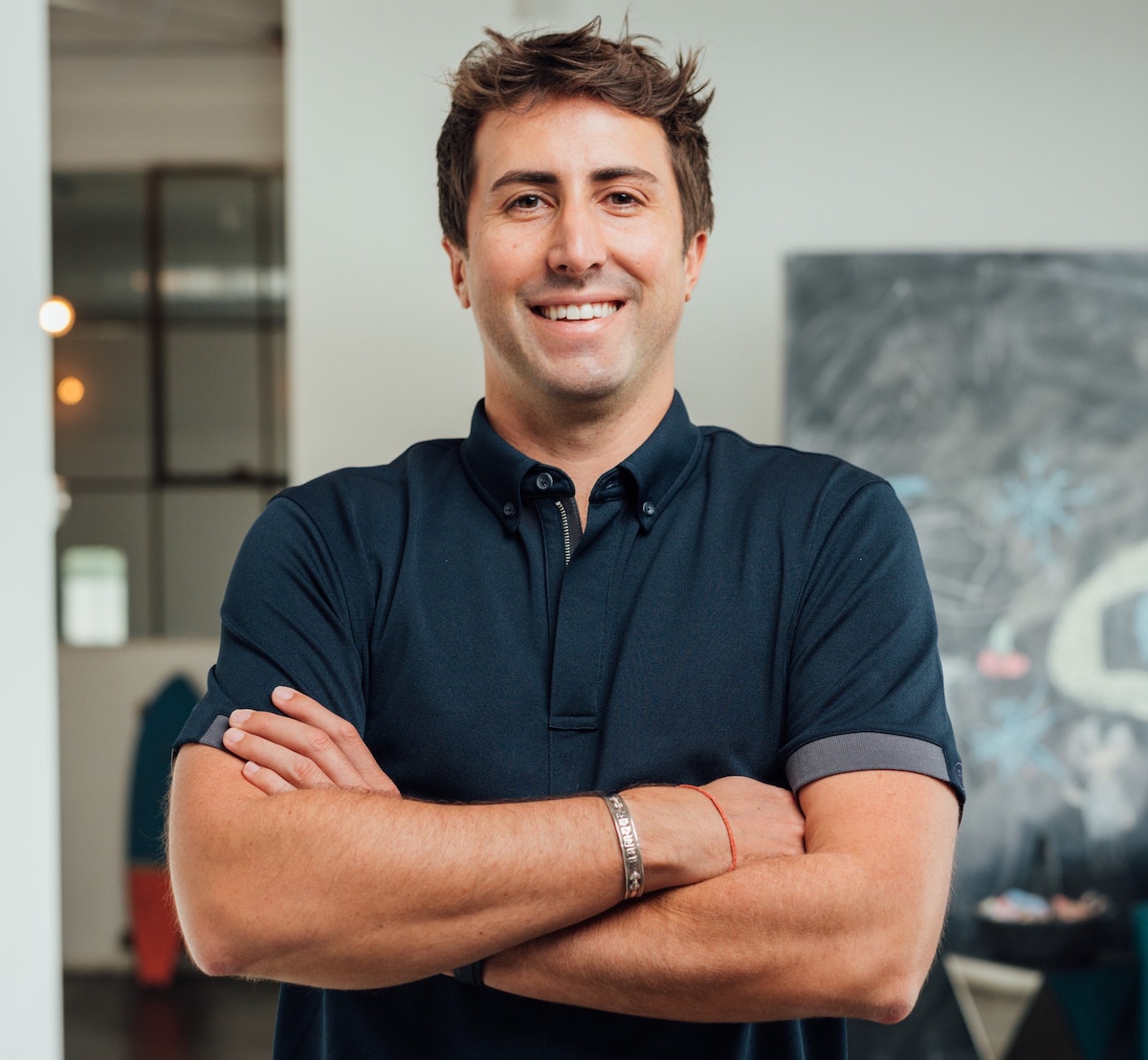 Image: Jason Wilk, founder of fintech company Dave.
Image: Jason Wilk, founder of fintech company Dave.
A younger demographic
Dave’s demographic skews younger—80 percent are under 30, with an average age of 22. “They’re just out of college, learning how to manage their money for the first time,” Wilk told us. With the budgeting tools and need to pay back advances, Dave’s bear is intended to help users learn better money-management skills.
Even billionaire investor Mark Cuban, an early backer of the Dave app, says he “got crushed by overdraft fees in my 20s.”
Yet with 40 percent of Americans unable to cover a $400 emergency expense, it is not just younger people who find themselves cash strapped.
Recognizing that chronic overdrafting may be part of larger financial pressures, Dave’s app offers Side Hustle, which connects Dave users with side gigs to earn extra income. To participate, Dave users select the gigs they're interested in and are sent the information they need to get started. To date, Dave has received over 100,000 applications through the program.
Tip us and we’ll plant a tree
Dave doesn't make any money from the borrowing service aside from optional donations. Those donations—or tips, as Wilk describes them—make it possible “to help people without charging an interest rate,” he said.
For every percentage of a tip, Dave also donates a tree in sub-Saharan Africa through its partner, Trees for The Future. “I really wanted to have a charitable portion of the company, which is not typically what you see out there in the market. We thought planting trees could match up well with our gratuity model,” Wilk told 3p.
Images courtesy of Dave
'Ugly' Produce Delivery Company Expands Into Packaged Foods


You've probably heard the startling statistics about food waste in the U.S.—around 40 percent of all the food we produce ultimately goes uneaten. Most of this food is thrown away by consumers or consumer-facing businesses like restaurants and grocery stores. Additionally, worldwide more than 10 million tons of fruits and vegetables remain unharvested at farms every year, according to a 2016 report from Rethink Food Waste Through Economics and Data (ReFED), a multi-stakeholder nonprofit group.
In addition to factors like pests and weather conditions, on-farm food waste is often traced to shoppers' preference for fruits and veggies that are uniform in shape, size and color. That means grocers often opt not to purchase misshapen, oddly-colored or unusually-sized produce—exacerbating the waste problem and making it harder for farmers to turn a profit. “I would say at times there is 25 percent of the crop that is just thrown away or fed to cattle,” Wayde Kirschenman, who runs a family farm near Bakersfield, California, told the Guardian. “Sometimes it can be worse.”
On this front, food delivery company Imperfect Produce claims to offer a solution. Founded in 2015, the San Francisco-based company sells subscription delivery boxes filled with so-called "ugly" fruits and vegetables, at prices 30 percent lower than retail. Since its inception, Imperfect Produce has salvaged 40 million pounds of fruits and veggies that may have otherwise gone to waste, Fast Company reported.
This month, the company is expanding its discounted grocery lineup beyond produce to include other “imperfect” foods, such as packaged grains, nuts, oil, bread, and other pantry staples and snacks.
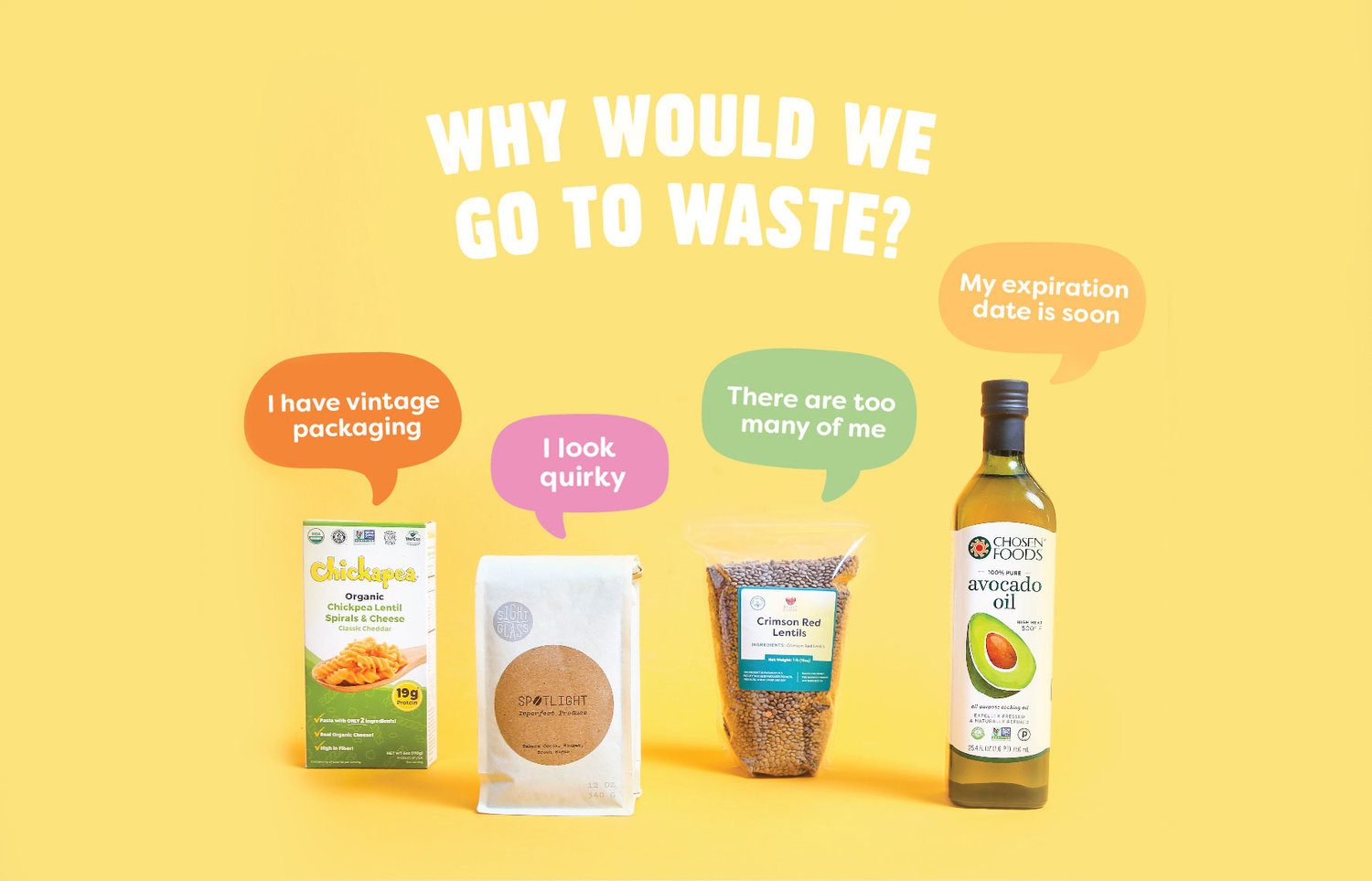
These include foods that are nearing their “best by” dates but are still perfectly edible, such as an avocado oil produced by Chosen Foods and made available through Imperfect’s initial packaged goods offering. Its so-called Imperfect Picks lineup also features products that can’t be sold in grocery stores because the manufacturer recently updated its branding or packaging, such as pastas from Chickapea and Blue Evolution and whole grain products from Bob’s Red Mill.
The company’s lineup also includes items that were over-ordered or cannot be sold due to irregular shape or size—such as “peaberries,” or undersized coffee beans, from Sightglass coffee. Additionally, the dried lentils in its lineup “were part of a massive order placed by a large buyer who downsized their purchase at the last minute, leaving an organic grain producer in Montana with 250,000 pounds of lentils,” Imperfect wrote on its blog.
Imperfect Produce is far from the only company in the ugly food game. Philadelphia-based Misfit Markets sells similar subscription boxes filled with funny-looking fruits and vegetables, as does the Baltimore startup Hungry Harvest. At the retail level, grocers around the world are embracing these formerly forgotten foods—including Sainsbury’s in the U.K., Intermarché in France, Loblaw in Canada and Kroger in the U.S. Imperfect also collaborated with Whole Foods back in 2016 to make misshapen fruits and veggies available on store shelves.
However, not everyone is sold on the sale of “ugly” food—and particularly ugly produce—as a means of combatting food waste. “As the Atlantic reported, criticisms of ugly produce delivery companies range from them rerouting produce that might otherwise reach food pantries, to them encroaching on turf that once belonged to community farmers,” Ben Paynter wrote in Fast Company.
On the farmer side, reviews are mixed. The Atlantic interviewed the business manager of an organic growers cooperative in Pennsylvania, who said ugly produce delivery company Misfits Market helped farmers earn a profit for produce that couldn’t be sold at grocery stores and was too much to sell in farmers markets alone. But the magazine also covered a Washington organic farm that partially blamed ugly produce companies for forcing it out of business.
“Honestly, the criticisms are a bit surprising,” Ben Simon, co-founder and CEO of Imperfect Produce, told the New Republic in January. He pointed reporters to a blog post where he responded to critics of the company’s business model, in which he wrote: “Our mission to eliminate food waste and build a better food system for everyone is not a side-project or afterthought; it’s our reason for being.”
The company’s consumer communications appear to back up Simon’s assertion that Imperfect Produce is genuinely invested in the fight against food waste. Most of its social media postings center around tips to help people shop smarter and store food more effectively to avoid spoilage.
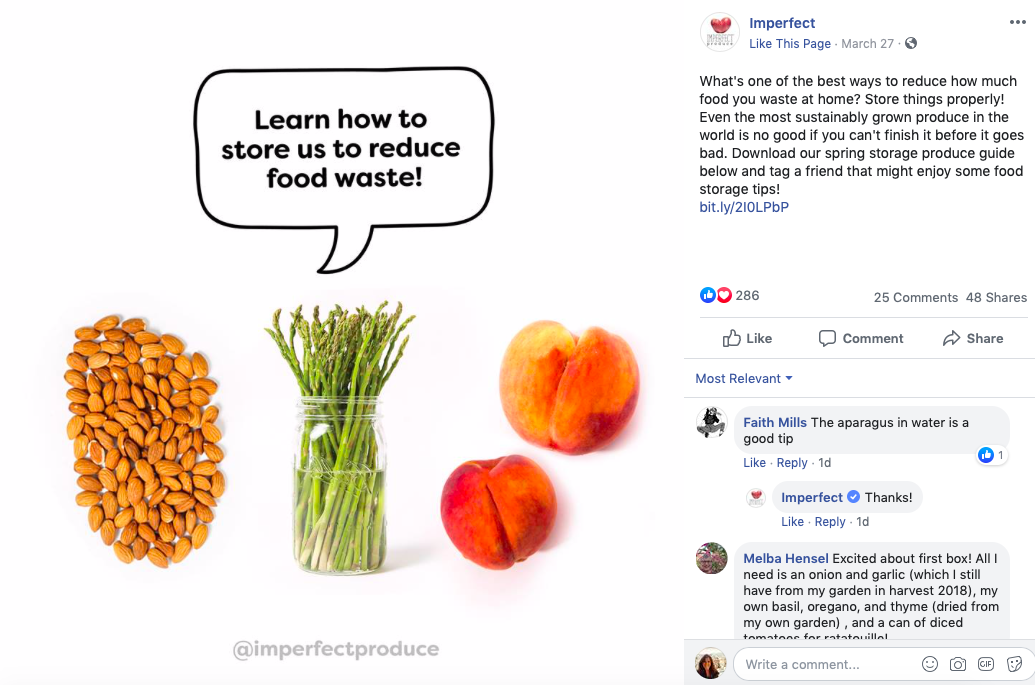
On the equity front, Imperfect works with nonprofit organizations like Urban Gleaners to provide ugly fruits and vegetables to low-income households for free. It also offers discounted food boxes for people who meet the income qualifications for the Supplemental Nutrition Assistance Program (SNAP, also known as food stamps)—which takes $150,000 per month to subsidize, Fast Company reported. “We lose money on all these orders, but do it because it’s the right thing to do and because we believe passionately that nobody should be priced out of good food,” Simon wrote in his blog post.
And, as Paynter of FastCo pointed out, the company makes its services available in every ZIP code of the cities it serves, unlike many other subscription box companies.
As Simon concedes, “Imperfect is not and never will be a silver bullet for every problem plaguing the food system.” But all criticism aside, one thing is clear: This social enterprise is growing quickly. Along with its expanded product offerings, the company—which counts NBA star Kevin Durant among its investors—is looking to expand into a dozen new markets this year and recently brought its subscription box service to the Twin Cities, Philadelphia and Madison, Wisconsin.
Image credits: Cindy Shebley/Flickr; Imperfect Produce via The Imperfect Digest and Facebook
SC Johnson Says It's Offering More Concentrate Products To Combat Plastic Waste


Global consumers use a million plastic bottles every minute, 90 percent of which are not recycled. Family-owned household products company SC Johnson is offering a simple solution by asking consumers to swap the same products they already use for concentrates that reduce plastic waste.
Concentrate products—cleaning products, specifically, in SC Johnson's case—can be combined with tap water in reusable bottles, minimizing the packaging and transport of containers that are mostly filled with water. "Every single time you use a concentrate bottle, you use nearly 80 percent less plastic waste," CEO Fisk Johnson, a fifth generation member of his family to lead the private company, said in statement.
SC Johnson is no stranger to the concentrate game. The company first released a concentrated version of its Windex window cleaner back in 2011 and has since steadily expanded its refill options to other popular cleaning brands, including Pledge, Scrubbing Bubbles, Shout and Fantastik.
The new line of SC Johnson concentrates will roll out in the U.S. and Canada starting this month. The items will hit Amazon and other e-commerce retailers—including Target and Walmart websites—first, according to the company. The next wave of concentrate refills, including Scrubbing Bubbles, Windex and Mr. Muscle, will be available online in Mexico starting in July and in the United Kingdom a month later. China and Japan will follow in September.
The company claims its reusable trigger bottles deliver more than 10,000 sprays and can be refilled dozens of times. This simple swap is a light lift for the consumer, and it can make a big impact, according to the company. “Refilling with a concentrate is a small change that could make a real difference in minimizing plastic waste,” Johnson said.
For consumer goods companies, taking steps to minimize plastic packaging is no longer a nice-to-have. It's emerging as an economic imperative. For example, in June 2018, a group of 25 institutional investors with a combined $1 trillion in assets called plastic pollution a clear corporate brand risk and pledged to engage with consumer goods companies on packaging solutions. Multi-stakeholder groups, such as the Ellen MacArthur Foundation's New Plastics Economy and NextWave, continue to call on companies to embrace a circular economy—in which materials are infinitely reused and nothing becomes waste.
SC Johnson says it's continuing to push for increased circularity of its product packaging. For example, its Windex bottles have been made with 100 percent post-consumer recycled plastic since 2015, and the company recently released a 100 percent recycled ocean plastic bottle—a first for a home cleaning brand, according to SC Johnson.
The Wisconsin-based company says it's also looking to tackle ocean plastic waste by cutting it off at the source. Around two-thirds of the plastic that enters the ocean from rivers is carried by only 20 waterways—the majority of which are on the Asian continent, where access to waste collection and recycling is often limited.
"Efforts to improve recycling infrastructures in this part of the world are paramount," an SC Johnson press statement reads. "By raising collection rates to an average of roughly 80 percent across [China, Indonesia, the Philippines, Vietnam and Thailand], plastic-waste leakage into the ocean would be reduced by almost 25 percent." That's a huge deal considering that, at this rate, the oceans will contain more plastic than fish by 2050, according to the World Economic Forum.
As 3p reported last year, SC Johnson is partnering with Canadian startup Plastic Bank in a blockchain-enabled pilot project to collect and recycle plastic in eight Indonesian communities, with plans to expand. Through Plastic Bank's model, everyday people can pick up plastic and sell it to local recycling centers in exchange for digital tokens—aka blockchain-enabled cryptocurrencies—solving dual challenges of plastic waste and poverty, the startup says.
Because the plastic it collects is tied to the blockchain, which is essentially a digital ledger book, Plastic Bank allows manufacturers to track and purchase the material under the Social Plastic name. The Social Plastic moniker is both a marketing angle and a way to communicate values and purpose to consumers.
German consumer goods company Henkel and British retailer Marks and Spencer have already used Social Plastic in products and packaging. At SC Johnson, plans are underway to launch a 100 percent Social Plastic Windex bottle by this fall, the company said.
Image courtesy of SC Johnson